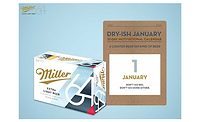2019 Beer Report: Domestic beers dominance continues despite declines
Beer manufacturers rally around Beer Growth Initiative

With dollar sales reaching approximately $112 billion, the U.S. beer market continues to be one of the top categories based on dollar sales in the overall beverage industry, according to Chicago-based Mintel. However, although dollar sales have seen slight increases, volume sales have been challenged in recent years.
“The beverage alcohol market continues to evolve with beer losing share to both spirits and wine,” says Brian Sudano, managing partner for New York-based Beverage Marketing Corporation (BMC). “The continued splintering of consumer’s considered brand set that includes spirits and wine in more occasions will continue to put pressure on beer per caps.”
Because of this splintering, members of the beer community are looking to tackle these challenges through a group effort. At its 81st Convention, the National Beer Wholesalers Association unveiled the Beer Growth Initiative (BGI), an industry-wide effort to improve the category health of the beer industry.
In partnership with the Brewers Association and the Beer Institute, the effort is designed to identify opportunities to grow the beer category while bringing together large brewers, small brewers, distributors and industry experts to address beer’s steady decline during the past few years, the association says.
This initiative comes as the off-premise U.S. beer market decreased 0.3 percent in terms of volume sales in 2018 while being up 1.8 percent in dollar sales for that same time period, says Patrick Livingston, director of client insights of beer, wine and spirits for Chicago-based Information Resources Inc. (IRI), citing the market research firm’s sales data across total multi-outlets including the convenience channel sector.
Analyzing this performance, Livingston notes that a number of factors are contributing to the beer market’s relatively flat performance in 2018. “There are fewer households that purchased the beer category in 2018 compared to 2017, so there’s a decrease in household penetration — just about four-tenths of a percent, which is small,” he says. “However, there is a decrease in penetration.”
Costs of premiumization
As the beer market looks to increase volume growth, many experts note the impact that the mass market domestic beer segment will have on that goal.
“Many argue that the beer category cannot return to health in the short term without a healthy premium core,” Livingston says. “… This segment, premium beer, makes up 40.5 percent of the beer category.”
(Brand family)
| DOLLAR SALES | % CHANGE VS. PRIOR YEAR | CASE SALES | % CHANGE VS. PRIOR YEAR | |
| Bud | $7,320,205,119 | -5.3 | 342,680,493 | -6.2 |
| Coors | $2,513,932,983 | -3.8 | 119,658,166 | -4.8 |
| Miller Lite | $2,010,961,224 | -1.2 | 96,762,133 | -2 |
| Yuengling | $388,688,707 | 1.3 | 16,638,184 | -1 |
| Rolling Rock | $129,803,897 | -9 | 7,855,367 | -7.9 |
| Total sales* | $12,601,135,426 | -4.2 | 595,819,788 | -5.1 |
*Includes brands not listed.
Source: Information Resources Inc. (IRI), Chicago. Total U.S. supermarkets, drug stores, gas and convenience stores, mass merchandisers, military commissaries, and select club and dollar retail chains for the 52 weeks ending Dec. 30, 2018.
He adds that when adding the sub-premium domestic beer segment, these make up approximately two-thirds of beer market share. “These are very large segments and they’re very important to the health of the beer category,” Livingston says.
However, premium beer declined 5.1 percent in volume for the 52 weeks ending Dec. 30, 2108, according to IRI data.
Among the current trends impacting the domestic premium beer market, BMC’s Sudano notes that premiumization continues to be at the forefront. “The long-term trend is to trade up,” he says. “Recently the majors have gotten aggressive on price within the value segment making beer more competitive to price-sensitive consumers. This has resulted in improved value beer trends but worsening of the premium domestic beer segment. Overall, this is negative for domestic dollar sales.”
(Brand family)
| DOLLAR SALES | % CHANGE VS. PRIOR YEAR | CASE SALES | % CHANGE VS. PRIOR YEAR | |
| Michelob | $2,121,572,436 | 18.8 | 78,938,379 | 15.9 |
| Bud Specialty | $707,501,836 | 3 | 23,022,054 | 0.3 |
| Landshark | $45,870,518 | -1.2 | 1,681,516 | -1.1 |
| Budweiser Reserve Collection | $36,493,453 | 703.8 | 1,170,489 | 711.8 |
| George Killian's | $12,945,080 | -13.8 | 485,717 | -14.1 |
| Total sales* | $2,943,102,055 | 15.2 | 106,292,688 | 12.9 |
*Includes brands not listed.
Source: Information Resources Inc. (IRI), Chicago. Total U.S. supermarkets, drug stores, gas and convenience stores, mass merchandisers, military commissaries, and select club and dollar retail chains for the 52 weeks ending Dec. 30, 2018.
IRI’s Livingston also details the impact of premiumization. “We think that consumers are choosing more premium beer options,” he says. “We also think they are increasing their consumption of spirits and reducing consumption of some beer products. These are longer term trends; they’ve been around for a while, we call it the premiumization of the alcohol category. It might be a positive for beverage alcohol in total but it specifically places a strain on the premium beer segment.”
Supporting this assessment, Livingston points out that household penetration of premium beer was 18.9 percent in 2018 compared with nearly 20 percent in 2017. However, he notes that the dollars that each household is spending on premium beer each year is flat, highlighting again the penetration impact.
However, not all domestic segments were down for 2018. The domestic super-premium beer segment was up 12.9 percent in terms of volume for 2018, based on IRI data. BI
Looking for a reprint of this article?
From high-res PDFs to custom plaques, order your copy today!





